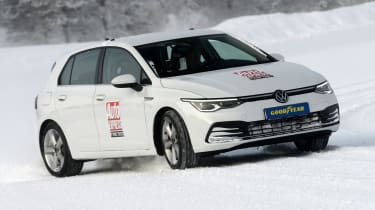Best all-season tyres 2022
Which tyres should you fit to ensure you’re prepared to face all conditions throughout the year?
Drivers looking for the best way to cope with increasingly extreme weather are turning to all-season tyres, because they provide vastly improved grip in winter over conventional alternatives, without the cost and aggravation of changing tyres twice a year.
But no tyre can be best in the wet, dry and snow, so manufacturers have to decide where they want their tyre to perform best. That decision and how much performance they give up elsewhere is why we test all-season tyres every year, and this time round we return to the massively popular 225/45R17 size.
We’re also back to some sort of normality after two years where our testing was disrupted by the Covid-19 pandemic and the resulting travel restrictions. We were able to buy almost all of our tyres, and where they were supplied, we compared them later with bought samples to ensure they were as tested.
With the help of Goodyear, we completed the snow tests at the company’s Arctic Center facility in northern Finland, while the wet and dry assessments were done with Continental at the firm’s Contidrom in Hanover, Germany.
What we tested...
There’s a familiar look to the test line-up, with Hankook, Bridgestone, Continental, Goodyear and Avon returning with the same tyres we tested in 16-inch form last year.
The new Michelin CrossClimate 2 makes its Auto Express test debut, while Vredestein is back, but this time with the Quatrac Pro.
On the right we’ve listed the weight and speed ratings tested, plus the tyre label ratings. A is best for fuel economy (RR) and wet grip (WG), while the lower the decibel number the better for pass-by noise (N).
| Tyre | Load | Speed | Economy / Rolling Resistance (RR) | Wet grip (WG) | Noise (N - decibels) |
| Avon AS7 All Season | 94 | W | D | B | 70 |
| Bridgestone Weather Control A005 EVO | 94 | W | C | A | 72 |
| Continental AllSeasonContact | 94 | V | C | B | 72 |
| Goodyear Vector 4Seasons Gen-3 | 94 | W | C | B | 70 |
| Hankook Kinergy 4S2 | 94 | W | C | B | 72 |
| Michelin CrossClimate 2 | 91 | W | C | B | 71 |
| Vredestein Quatrac Pro | 94 | Y | D | B | 71 |
How we tested the tyres
The variations in the UK’s weather mean all-season tyres have a growing appeal as a one-stop solution for dry conditions, rain and snow. But our climate means wet performance is at the heart of our test.
Wet
Our tests assessed straight-line and lateral grip, plus how the tyres deal with deep water. Braking was measured from 80-0kph (50-0mph) using Continental’s rail system, which ensured the same piece of track is used each time, improving consistency.
Lateral grip was measured on the 57.5m tarmac circle. The car was tucked close to the inner edge and accelerated until the line could no longer be held.
Deep water ability is rated in a straight line and when cornering. The speed when the wheel in the water spins 15 per cent more than the one in dry is measured for the longitudinal hydroplaning test. In the lateral test the car is driven round a tarmac circle with a flooded portion at increasing speeds. The g force is measured until it is lost. These elements came together in the handling test, where the result was based on lap times.
Snow
While wet tests are critical, performance in snow is still important. Auto Express drivers assessed traction and braking by measuring the distance taken from 8-30kph (5-19mph) and to slow from 50-5kph (31-3mph).
Just as in the wet evaluations, lateral grip was measured in a circle and around the handling track. The same technique as in the wet was used on the circle, while the handling track’s sweeps, climbs and drops tested each tyre’s grip and balance.
Dry
Braking was measured from 100kph (62mph) to a stop, and the time taken to complete a section of the Contidrom handling track was used to measure cornering grip and assess balance.
All the braking, aquaplaning and cornering results are an average of multiple tests with any rogue results omitted.
Noise
A sound meter was used to measure noise levels as we coasted down from 50mph over three surfaces: smooth and rough tarmac, plus concrete slabs. This should not be confused with the EU tyre-label noise rating which is for pass-by noise, and there is no direct correlation between the two.
Fuel economy
Rolling resistance is at the heart of this assessment, because it measures the amount of power needed to turn each loaded tyre. The easier a tyre rolls, the less power and fuel is required. A five per cent shift in rolling resistance will see around a one per cent change in fuel consumption.
Price
Our online tyre retailer test winner Black Circles provided the tyre prices, which were correct at the time of writing. Pricing plays a very small role in the overall rating.
How we chose a winner
After the results were converted to percentages, we split them into wet, dry and snow categories, plus one for noise, fuel consumption and price. To reflect UK weather, we gave 50 per cent of the scores to wet performance, 30 to dry results and 10 each for the other two. Within the wet and snow sections, the emphasis was put on handling and braking. In the results, the winner’s performance is rated 100 per cent and the rest ranked relative to that.






